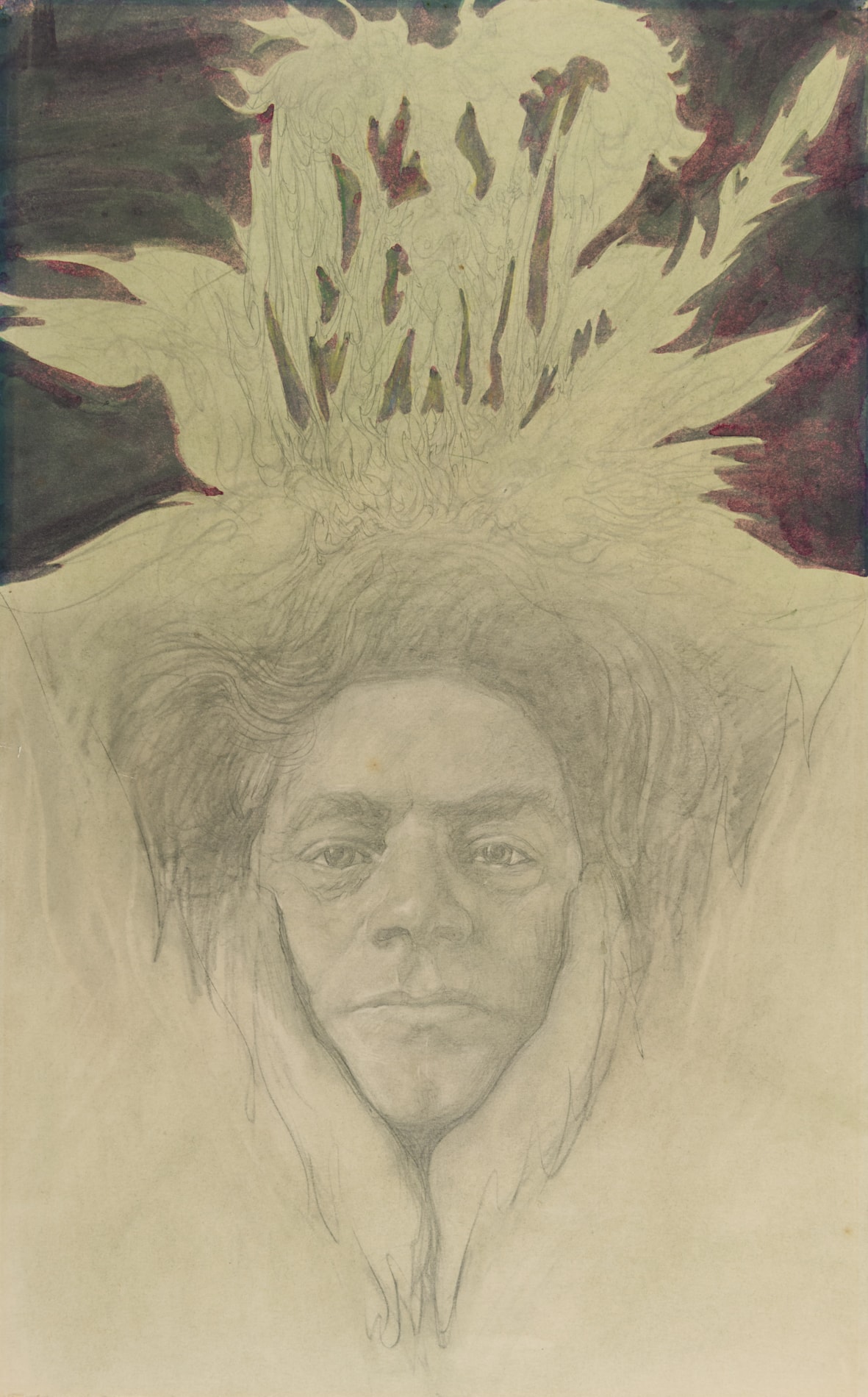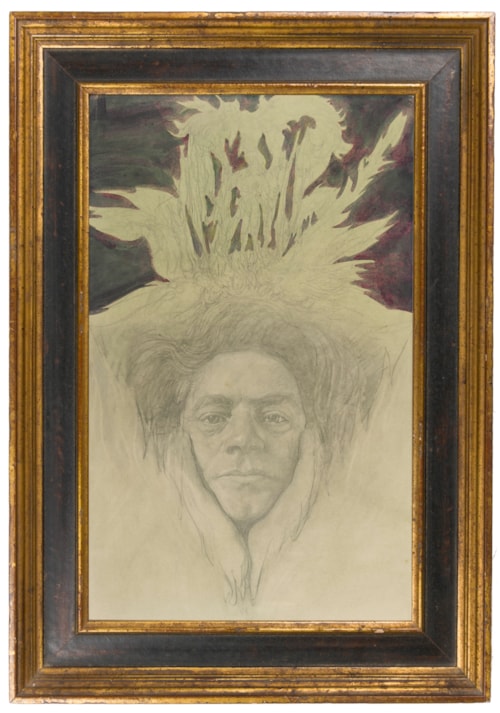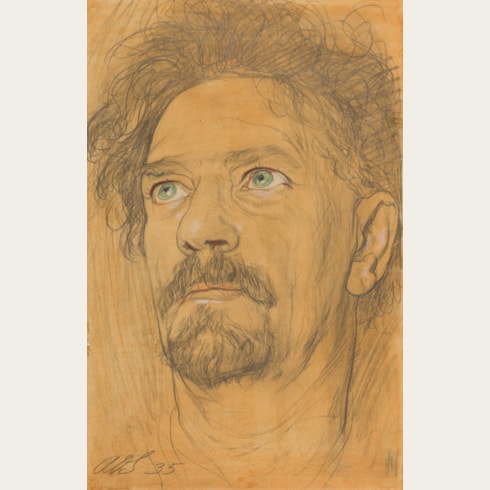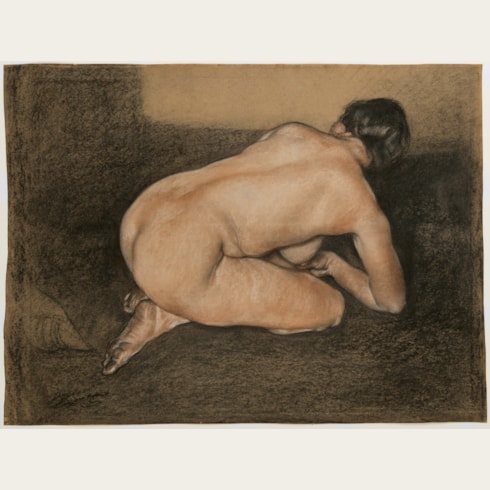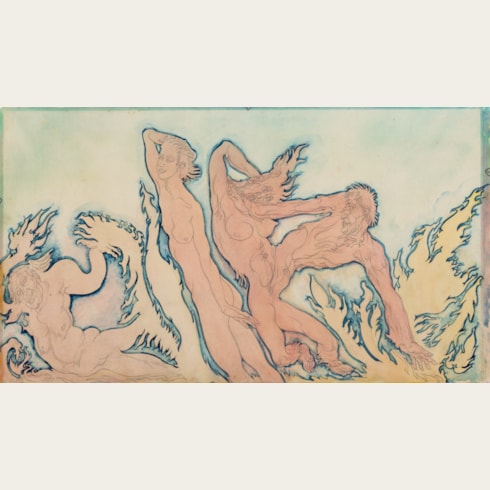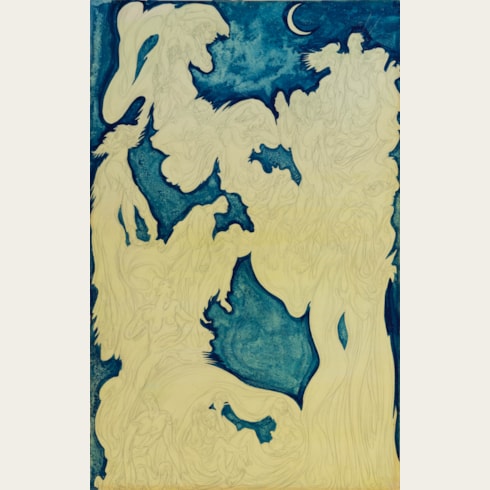Austin Osman SPARE
(London 1886 - London 1956)
Palimpsest
Sold
Pencil and watercolour on board.
Inscribed and titled P / A.O. SPARE / “Palimpsest” / 6-2=143 the reverse of the board.
490 x 308 mm. (19 1/4 x 12 1/8 in.)
Inscribed and titled P / A.O. SPARE / “Palimpsest” / 6-2=143 the reverse of the board.
490 x 308 mm. (19 1/4 x 12 1/8 in.)
Throughout his life, Austin Osman Spare was recognized as an outstanding draughtsman. An obituary of the artist in The Times noted that ‘Mr. Austin Spare, an artist of unusual gifts and attainments and even more unusual personality, died yesterday in hospital in London…He worked chiefly in pastel or pencil, drawing rapidly, often taking no more than two hours over a picture…His minute draughtsmanship may have owed something to the Pre-Raphaelite influence, though in general his art was much more human and full-blooded than that of the “brethren”. Of his technical mastery there can be no manner of doubt. The collection of his drawings may yet become a cult.’
Datable to c.1928-1929 and typical of many of Spare’s portraits in its unsettling intensity, the present sheet is possibly a self-portrait. Always particularly interested in achieving and expressing a heightened self-awareness, he produced powerful self-portrait drawings, pastels and paintings throughout his career. The title Palimpsest, in various forms, appears several times in Spare’s work, as early as his exhibitions at the Lefevre Gallery in 1929 and the Godfrey Phillips Gallery the following year, in which the present sheet may have been included. Two works entitled Palimpsest (Face in Body) and Palimpsest (Profile) were exhibited at the artist’s home in Brixton in the early 1940s, while other works with similar titles appeared in Spare’s exhibition at the White Bear pub in 1953 and at his final show at the Archer Gallery in 1955.
As the Spare scholar William Wallace has noted, recording the statements of two of the artist’s closest friends, ‘[Kenneth] Grant recounts…that he visited Hannen Swaffer, the ace journalist one evening in the late 1940s…Swaffer showed him two large drawings that he was unable to hang on his walls (of which two were covered with Spare’s works), as the line-work was so pure and fine that it did not register on the eye. These do indeed sound like examples of Spare’s palimpsest method, achieved – as Frank Letchford explained to me in conversation – by rubbing down the drawing with dry crumbled bread to ‘lift’ some of the graphite from the indented lines...My own view is, that as drawings with a strong quasi-automatic element as a fundamental aspect in their process, these palimpsests by Spare might owe some debt to the essay Suspira de Profundis of Thomas de Quincey (1786-1859), specifically in the section ‘The Palimpsest of the Human Brain’. It is perhaps significant that a drawing entitled ‘Palimpsest’ appears as No.31 in the 1930 Godfrey Phillips catalogue whilst ‘De Profundis’ is No.46. In his essay, De Quincey deftly catalogues the term: ‘A palimpsest then, is a membrane or roll cleansed of its manuscript by repeated successions’…Spare’s palimpsests are, quite literally, automatic expressions and represent attempts to reify the incarnations of the archaic unconscious mind.’
Datable to c.1928-1929 and typical of many of Spare’s portraits in its unsettling intensity, the present sheet is possibly a self-portrait. Always particularly interested in achieving and expressing a heightened self-awareness, he produced powerful self-portrait drawings, pastels and paintings throughout his career. The title Palimpsest, in various forms, appears several times in Spare’s work, as early as his exhibitions at the Lefevre Gallery in 1929 and the Godfrey Phillips Gallery the following year, in which the present sheet may have been included. Two works entitled Palimpsest (Face in Body) and Palimpsest (Profile) were exhibited at the artist’s home in Brixton in the early 1940s, while other works with similar titles appeared in Spare’s exhibition at the White Bear pub in 1953 and at his final show at the Archer Gallery in 1955.
As the Spare scholar William Wallace has noted, recording the statements of two of the artist’s closest friends, ‘[Kenneth] Grant recounts…that he visited Hannen Swaffer, the ace journalist one evening in the late 1940s…Swaffer showed him two large drawings that he was unable to hang on his walls (of which two were covered with Spare’s works), as the line-work was so pure and fine that it did not register on the eye. These do indeed sound like examples of Spare’s palimpsest method, achieved – as Frank Letchford explained to me in conversation – by rubbing down the drawing with dry crumbled bread to ‘lift’ some of the graphite from the indented lines...My own view is, that as drawings with a strong quasi-automatic element as a fundamental aspect in their process, these palimpsests by Spare might owe some debt to the essay Suspira de Profundis of Thomas de Quincey (1786-1859), specifically in the section ‘The Palimpsest of the Human Brain’. It is perhaps significant that a drawing entitled ‘Palimpsest’ appears as No.31 in the 1930 Godfrey Phillips catalogue whilst ‘De Profundis’ is No.46. In his essay, De Quincey deftly catalogues the term: ‘A palimpsest then, is a membrane or roll cleansed of its manuscript by repeated successions’…Spare’s palimpsests are, quite literally, automatic expressions and represent attempts to reify the incarnations of the archaic unconscious mind.’
Arguably one of the most gifted draughtsmen of Edwardian London, and today perhaps among the least well-known, Austin Osman Spare was born in Smithfield in London - a true Cockney - on the penultimate day of 1886. He drew constantly from a very early age, and by the end of his life had produced over two thousand drawings, watercolours and pastels. Although he was largely self-taught, from the age of about twelve he took evening classes at the Lambeth School of Art, where his fellow pupils included Glyn Philpot. Among his early artistic influences were Aubrey Beardsley and George Frederick Watts, and he was also a voracious reader, particularly of the Theosophical writings of Madame Blavatsky. In 1903 Spare won a silver medal in the National Competition of Schools of Art, representing Lambeth, and the following year a first exhibition of his drawings was held at the public library in Newington. Likewise in 1904, the seventeen-year-old Spare had a drawing accepted at the Royal Academy Summer Exhibition, becoming one of the youngest exhibitors ever. This earned him much comment and praise as something of a ‘boy genius’ from journalists and critics, as well as, it is said, from such fellow artists as Watts, Augustus John and John Singer Sargent. Having been recommended by the artist William Blake Richmond for a scholarship to the Royal College of Art, Spare found the institution unsuited to his style and temperament, and soon began skipping classes. He left the school in 1905, without any qualifications, and the same year self-published Earth: Inferno; his first book of drawings and mystical texts (‘Strange Desires and Morbid Fancies’, in his words). Another of his drawings was shown at the Royal Academy in 1905, and at around the same time began to work as a book illustrator and a designer of bookplates. In 1907 a second volume of Spare’s drawings was published, entitled A Book of Satyrs and containing eleven striking images of satirical subjects.
Spare had his first proper exhibition at the Bruton Gallery in London in 1907. ‘Black and White Drawings by Austin O. Spare’ resulted in a number of reviews, most of which commented equally on the sheer technical proficiency of the works and their weird and disturbing subject matter. As one reviewer noted, the exhibition ‘will probably be the talk of the London studios for many a day to come. In speaking of his pen and ink work it is difficult to avoid superlatives. His craftsmanship is superb; his management of line has not been equalled since the days of Aubrey Beardsley; his inventive faculty is stupendous and terrifying in its creative flow of impossible horrors.’ It was at the Bruton Gallery that Spare first met the occultist Aleister Crowley, who joined a small but growing band of patrons and collectors of the young artist’s work, notably the designer Pickford Waller. Spare, who had a lifelong interest in the occult, provided a number of illustrations for Crowley’s journal The Equinox. Further exhibitions of his drawings in West End galleries followed in 1911, 1912 and 1914, while in 1913 Spare’s The Book of Pleasure (Self-Love): The Psychology of Ecstasy was self-published.
In 1916 Spare founded and co-edited the magazine Form: A Quarterly of the Arts. Lavishly produced but also criticized for its eccentric layout, the journal lasted for only two issues before it ceased publication with the outbreak of the First World War, when Spare was conscripted into the Royal Army Medical Corps and worked as an Official War Artist. The journal was briefly revived after the war but Spare soon moved on to a new project, a literary and artistic journal called The Golden Hind, which ran for eight issues, until 1924. By now he was living in relative squalor in a council flat in Borough in South London, and his next project was an album of ‘automatic’ grotesque drawings, entitled The Book of Ugly Ecstasy, of which the sole copy was purchased in 1924 by the art historian Gerald Reitlinger. (His brother, the Old Master drawing collector Henry Scipio Reitlinger, also acquired some drawings by Spare in the 1920s.) Although Spare was producing some of his best drawings by the end of the 1920s, exhibitions of his work at the St. George’s Gallery in Hanover Square in 1927 and at Alex. Reid and Lefevre in 1929 were commercial and critical failures, as was a 1930 show of anamorphic portraits in watercolour (which the artist titled ‘Experiments in Relativity’) at a gallery in St. James’s, which was to be his final West End exhibition. By this time, Spare had begun to exhibit and sell his drawings from his South London flat, and had fallen into something of a depression.
Spare moved in 1936 to a large but spartan studio space near the Elephant and Castle in London, where he was able to hold exhibitions of his work, and where he began a School of Draughtsmanship. The same year he received a most unusual request; to paint the portrait of Adolf Hitler in Berlin. Apparently, someone at the German embassy in London had purchased a portrait or self-portrait by Spare and had sent it to the Führer as a present. (The work in question may even have been a self-portrait of the artist ‘as Hitler’, since Spare had a similar small moustache at this time.) Hitler was, it seems, impressed enough by Spare’s talent to offer to fly the artist to Germany, but the artist brusquely rejected the proposed commission.
In May 1941 Spare’s studio was completely destroyed by a German bomb, resulting in the loss of everything he owned, including several hundred works. His right arm was severely injured, so that he was unable to draw for several months, and he also suffered from memory loss. Soon living in a tiny basement room in Brixton in abject poverty, dressed in tattered clothes and sleeping on two chairs since he had no bed, Spare nevertheless continued to draw, filling sketchbook after sketchbook with drawings. An exhibition at the Archer Gallery in Westbourne Grove in 1947 was a great success, and from 1949 onwards Spare began to hold exhibitions in a series of South London pubs; The Temple Bar in 1949, The Mansion House in 1952 and The White Bear in 1953. He remained quite impecunious, however, largely due to his refusal to produce commercial portraits. He turned down numerous requests for portrait commissions, once remarking to his friend and acolyte Kenneth Grant, ‘I can only do portraits in the quiet of my own rooms…with the best intentions I don’t know how I should get a drawing board and easel to any particular place and at a certain time. Which is the reason I have never troubled to do portraits for a living – but tramps, charwomen, etc…Studies of heads - Yes! But with no thought of sale – that would kill me at once.’ He remained intensely prolific until the end of his life, however, and his last exhibition, at the Archer Gallery in 1955, included over 220 works. The following year, on the 15th of May, Spare – already in poor health - died from peritonitis following a burst appendix, at the age of sixty-nine. That evening, a newspaper noted that ‘A strange and gentle genius died in a London hospital this afternoon. You have probably never heard of Austin Osman Spare. But his should have been a famous name.’
Works by Austin Osman Spare are today in the collections of the British Museum, the National Portrait Gallery, the Victoria and Albert Museum, the South London Gallery and the Imperial War Museum in London, as well as the Ashmolean Museum in Oxford, the City Art Gallery in Manchester and the National Museum of Wales in Cardiff.
As the contemporary writer and graphic novelist Alan Moore has noted, ‘In his relation to both art and occultism, Austin Osman Spare stands out as a strikingly individual and even unique figure in fields that are by their very nature brimming with strikingly individual figures.’
Spare had his first proper exhibition at the Bruton Gallery in London in 1907. ‘Black and White Drawings by Austin O. Spare’ resulted in a number of reviews, most of which commented equally on the sheer technical proficiency of the works and their weird and disturbing subject matter. As one reviewer noted, the exhibition ‘will probably be the talk of the London studios for many a day to come. In speaking of his pen and ink work it is difficult to avoid superlatives. His craftsmanship is superb; his management of line has not been equalled since the days of Aubrey Beardsley; his inventive faculty is stupendous and terrifying in its creative flow of impossible horrors.’ It was at the Bruton Gallery that Spare first met the occultist Aleister Crowley, who joined a small but growing band of patrons and collectors of the young artist’s work, notably the designer Pickford Waller. Spare, who had a lifelong interest in the occult, provided a number of illustrations for Crowley’s journal The Equinox. Further exhibitions of his drawings in West End galleries followed in 1911, 1912 and 1914, while in 1913 Spare’s The Book of Pleasure (Self-Love): The Psychology of Ecstasy was self-published.
In 1916 Spare founded and co-edited the magazine Form: A Quarterly of the Arts. Lavishly produced but also criticized for its eccentric layout, the journal lasted for only two issues before it ceased publication with the outbreak of the First World War, when Spare was conscripted into the Royal Army Medical Corps and worked as an Official War Artist. The journal was briefly revived after the war but Spare soon moved on to a new project, a literary and artistic journal called The Golden Hind, which ran for eight issues, until 1924. By now he was living in relative squalor in a council flat in Borough in South London, and his next project was an album of ‘automatic’ grotesque drawings, entitled The Book of Ugly Ecstasy, of which the sole copy was purchased in 1924 by the art historian Gerald Reitlinger. (His brother, the Old Master drawing collector Henry Scipio Reitlinger, also acquired some drawings by Spare in the 1920s.) Although Spare was producing some of his best drawings by the end of the 1920s, exhibitions of his work at the St. George’s Gallery in Hanover Square in 1927 and at Alex. Reid and Lefevre in 1929 were commercial and critical failures, as was a 1930 show of anamorphic portraits in watercolour (which the artist titled ‘Experiments in Relativity’) at a gallery in St. James’s, which was to be his final West End exhibition. By this time, Spare had begun to exhibit and sell his drawings from his South London flat, and had fallen into something of a depression.
Spare moved in 1936 to a large but spartan studio space near the Elephant and Castle in London, where he was able to hold exhibitions of his work, and where he began a School of Draughtsmanship. The same year he received a most unusual request; to paint the portrait of Adolf Hitler in Berlin. Apparently, someone at the German embassy in London had purchased a portrait or self-portrait by Spare and had sent it to the Führer as a present. (The work in question may even have been a self-portrait of the artist ‘as Hitler’, since Spare had a similar small moustache at this time.) Hitler was, it seems, impressed enough by Spare’s talent to offer to fly the artist to Germany, but the artist brusquely rejected the proposed commission.
In May 1941 Spare’s studio was completely destroyed by a German bomb, resulting in the loss of everything he owned, including several hundred works. His right arm was severely injured, so that he was unable to draw for several months, and he also suffered from memory loss. Soon living in a tiny basement room in Brixton in abject poverty, dressed in tattered clothes and sleeping on two chairs since he had no bed, Spare nevertheless continued to draw, filling sketchbook after sketchbook with drawings. An exhibition at the Archer Gallery in Westbourne Grove in 1947 was a great success, and from 1949 onwards Spare began to hold exhibitions in a series of South London pubs; The Temple Bar in 1949, The Mansion House in 1952 and The White Bear in 1953. He remained quite impecunious, however, largely due to his refusal to produce commercial portraits. He turned down numerous requests for portrait commissions, once remarking to his friend and acolyte Kenneth Grant, ‘I can only do portraits in the quiet of my own rooms…with the best intentions I don’t know how I should get a drawing board and easel to any particular place and at a certain time. Which is the reason I have never troubled to do portraits for a living – but tramps, charwomen, etc…Studies of heads - Yes! But with no thought of sale – that would kill me at once.’ He remained intensely prolific until the end of his life, however, and his last exhibition, at the Archer Gallery in 1955, included over 220 works. The following year, on the 15th of May, Spare – already in poor health - died from peritonitis following a burst appendix, at the age of sixty-nine. That evening, a newspaper noted that ‘A strange and gentle genius died in a London hospital this afternoon. You have probably never heard of Austin Osman Spare. But his should have been a famous name.’
Works by Austin Osman Spare are today in the collections of the British Museum, the National Portrait Gallery, the Victoria and Albert Museum, the South London Gallery and the Imperial War Museum in London, as well as the Ashmolean Museum in Oxford, the City Art Gallery in Manchester and the National Museum of Wales in Cardiff.
As the contemporary writer and graphic novelist Alan Moore has noted, ‘In his relation to both art and occultism, Austin Osman Spare stands out as a strikingly individual and even unique figure in fields that are by their very nature brimming with strikingly individual figures.’
Provenance
Sir John Richardson, New York
Thence by descent.
Thence by descent.
Literature
Seph Rodney, ‘Subtle and Finessed Depictions at the Master Drawings Fair’, Hyperallergic, 24 January 2022.
Exhibition
Possibly London, Alex. Reid & Lefevre Ltd., Drawings and Water-colours by Austin O. Spare, April 1929, no.52 (‘Palimpest’ [sic], priced at 18 gns.); Possibly London, Godfrey Phillips Gallery, Water-colours & drawings by Austin O. Spare, November - December 1930, no.31 (‘Palimpsest’).

